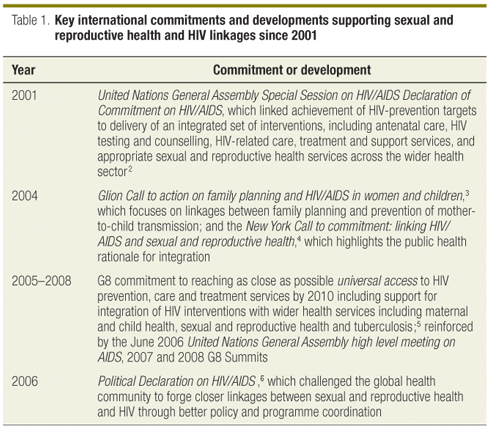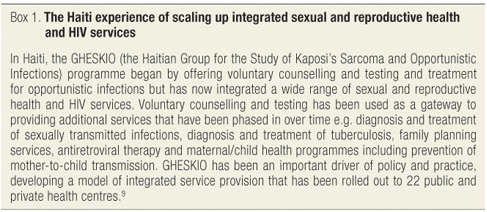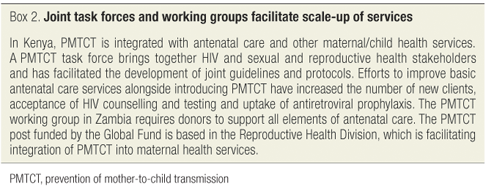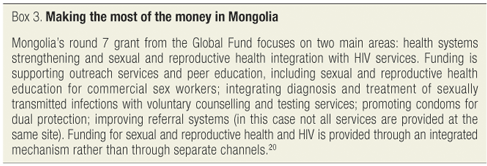POLICY & PRACTICE
Progress on scaling up integrated services for sexual and reproductive health and HIV
Progrès dans le développement de services intégrant à la fois la santé sexuelle et génésique et le VIH/sida
Progresos de la expansión de los servicios integrados de salud sexual y reproductiva y de VIH
Clare DickinsonI,*; Kathy AttawellII; Nel DruceI
IHLSP Institute, 5-23 Old Street, London, EC1V 9HL, England
IIIndependent consultant, London, England
ABSTRACT
This paper considers new developments to strengthen sexual and reproductive health and HIV linkages and discusses factors that continue to impede progress. It is based on a previous review undertaken for the United Kingdom Department for International Development in 2006 that examined the constraints and opportunities to scaling up these linkages. We argue that, despite growing evidence that linking sexual and reproductive health and HIV is feasible and beneficial, few countries have achieved significant scale-up of integrated service provision. A lack of common understanding of terminology and clear technical operational guidance, and separate policy, institutional and financing processes continue to represent significant constraints. We draw on experience with tuberculosis and HIV integration to highlight some lessons. The paper concludes that there is little evidence to determine whether funding for health systems is strengthening linkages and we make several recommendations to maximize opportunities represented by recent developments.
RÉSUMÉ
Le présent article examine les faits nouveaux allant dans le sens d'un renforcement des liens entre santé sexuelle et génésique et VIH/sida et étudie les facteurs qui continuent de s'opposer à ces progrès. Il s'appuie sur une revue réalisée antérieurement en 2006 par le Ministère britannique du développement international, qui examinait les obstacles et les possibilités rencontrés pour étendre ces liens. Nous affirmons que, malgré les preuves de plus en plus nombreuses de la faisabilité et des effets bénéfiques de lier les services de santé sexuelle et génésique à ceux relatifs au VIH/sida, peu de pays ont réalisé un développement conséquent de leur offre de services intégrés. Le manque de concepts terminologiques communs et d'instructions opérationnelles techniques claires, ainsi que la séparation des politiques et des processus institutionnels et financiers pour ces deux domaines continuent de représenter des obstacles importants. Nous avons attiré l'attention sur les leçons tirées de l'expérience avec l'intégration tuberculose/VIH/sida. L'article conclut qu'il existe peu de preuves que des investissements dans les systèmes de santé produisent un renforcement des liens examinés et formule plusieurs recommandations pour exploiter au maximum les opportunités offertes par les faits récents.
RESUMEN
En este artículo se analizan los recientes avances conseguidos con miras a reforzar los vínculos entre la salud sexual y reproductiva y el VIH y se examinan los factores que siguen dificultando los progresos en ese terreno. Se ha tomado como base un análisis anterior llevado a cabo por el Departamento Británico para el Desarrollo Internacional en 2006, en el que se examinaron las limitaciones y las oportunidades para extender masivamente esos vínculos. Sostenemos que, a pesar de la creciente evidencia de que la vinculación de los servicios de salud sexual y reproductiva y de VIH es factible y beneficiosa, son pocos los países que han logrado expandir de forma relevante la prestación integrada de servicios. La falta de una terminología común y de orientaciones operacionales técnicas claras, unida a la separación de los procesos normativos, institucionales y de financiación, siguen siendo obstáculos importantes. Hemos destacado algunas lecciones extraídas de la experiencia adquirida en la integración del control de la tuberculosis y del VIH. Se llega a la conclusión de que hay pocos datos probatorios para determinar si la financiación de los sistemas de salud está fortaleciendo los vínculos, y formulamos varias recomendaciones para aprovechar al máximo las oportunidades que brinda la reciente evolución de la situación.

Introduction
The importance of developing links between sexual and reproductive health and HIV services is widely recognized. Four priority areas for linkages - learning HIV status, promoting safer sex, optimizing links between HIV and sexually transmitted infection services and integrating HIV with maternal and infant health - could lead to significant public health benefits and improve efficient use of resources.1
This paper argues that, despite growing evidence that links between sexual and reproductive health and HIV services are feasible and beneficial, few countries have achieved significant scale-up of integrated services. It also looks at recent developments that represent opportunities to strengthen linkages and factors that impede progress. The paper follows recent usage of the term "linkages" as a generic description of links between policies, programmes and services.
Recent developments
Increased international commitment
This decade has witnessed greater commitment to sexual and reproductive health and HIV linkages (Table 1). More recent opportunities include policy developments within the Global Fund to Fight AIDS, Tuberculosis and Malaria (the Global Fund) to accept proposals that form linkages with sexual and reproductive health within the overall frameworks of HIV, tuberculosis (TB) and malaria. Also, there has been renewed commitment by the United States of America (USA) to international sexual and reproductive health through support of the United Nations Population Fund and the repeal of the Mexico City Policy, also known as the "global gag rule", a United States government policy that prohibited nongovernmental organizations from receiving federal funding for performing or promoting abortion services in other countries.

Health systems strengthening
Greater financing of health systems strengthening to deliver universal access targets and the health Millennium Development Goals can potentially address health system constraints that currently hinder the scale-up of integrated services.
The Global Fund Five-Year Evaluation notes that 35% of approximately US$ 4 billion has been directed to key health systems elements such as human resources, infrastructure and monitoring and evaluation, with round 7 approving US$ 86 million for cross-cutting funds supporting health systems.7 Furthermore, the proportion of funds for health systems strengthening is likely to increase in the future through the Global Fund's policy of national strategy applications from 2010.
Bilateral donors are also increasing resources for health systems strengthening and are prioritizing stronger linkages between sexual and reproductive health and HIV in the process. For example, the global AIDS strategy of the United Kingdom's Department for International Development commits US$ 6 billion up to 2015 for services that integrate HIV, TB, malaria and sexual and reproductive health including maternal/child health services. AusAID, the Australian government's overseas aid programme's new HIV strategy promotes the integration of HIV services into primary health care and is strengthening linkages between HIV services and TB, maternal/child health and sexual and reproductive health services. The reauthorization of the United States President's Emergency Plan for AIDS Relief (PEPFAR) emphasizes a continuation of HIV treatment but plans to collaborate with programmes such as malaria, TB and maternal/child health.
While additional funding for health systems strengthening offers the potential to strengthen sexual and reproductive health and HIV linkages, there is currently little documented evidence or case studies of where this is happening. The recent Global Fund Five-Year Evaluation reports that integration of prevention of mother-to-child transmission with general maternal care services still needs considerable expansion of scope.7
Emerging evidence of benefits
There is a growing body of evidence that shows the potential benefits of strengthening these linkages. A systematic review of evidence, Sexual & reproductive health and HIV. Linkages: evidence review and recommendations,8 examined linkages between services and identified the benefits as: (i) improved access to and uptake of services; (ii) better access to appropriate sexual and reproductive health services for people living with HIV/AIDS; (iii) reduced HIV-related stigma and discrimination; (iv) improved coverage of sexual and reproductive health services in key populations; (v) increased dual protection against unintended pregnancy, HIV and other sexually transmitted infections; (vi) improved provider motivation and quality of care; (vii) reduced duplication of effort and competition for resources; (viii) enhanced programme effectiveness and efficiency; and (ix) better utilization of scarce human resources for health. The review concluded that linking sexual and reproductive health and HIV is feasible, especially in family planning clinics, voluntary counselling and testing centres and HIV clinics. Positive outcomes reported included improved access to and uptake of services such as HIV testing and increased condom use. Where the cost-effectiveness of integrated services was measured, there appeared to be net savings from integrating HIV (and sexually transmitted infection) prevention into maternal/child health services. As an indicative example, experience from Haiti suggests it is both feasible and beneficial to use voluntary counselling and testing services as an entry point to integrating a broader range of sexual and reproductive health services (Box 1).

Success factors
Experience of scaling up integrated services for TB and HIV highlight several important success factors. In this case, setting national targets for collaborative activities facilitates implementation and helps to mobilize political support and stakeholders' engagement from both programmes. Creating a strong policy environment with appropriate policy and operational guidelines and training manuals has proved critical. Task delegation to front-line workers (such as capacity for HIV testing and counselling) and ensuring a regular supply of HIV test kits, drugs and commodities are also important factors (H Getahun, F Scano, P Nunn, unpublished data, 2008). Strong political leadership, effective national management and joint sexual and reproductive health/HIV policy and coordination mechanisms appear to be critical to building successful linkages. Kenya and Zambia have shown that, where there is strong commitment, progress can be achieved in scaling up prevention of mother-to-child transmission programmes through integration with mother/child health services (Box 2).10

Challenges
Despite increased commitment and financing, scaling up linkages and integrated services has been modest. Some of the major impediments and progress in addressing constraints are discussed here.
Weak global governance
A powerful guiding institution for sexual and reproductive health and HIV is lacking. United Nations agencies have played a key role in providing technical support but until recently no one agency has emerged to champion these linkages. Linkages have been slow to develop institutionally, with documentation and guidance notes for countries only emerging since 2007. Progress is being made to address these weaknesses: in 2008 a WHO-led Inter-Agency Working Group on sexual and reproductive health and HIV linkages with participation from civil society, networks of people living with HIV, donor and United Nations agencies was established. This group aims to accelerate progress towards universal access targets through stronger engagement between sexual and reproductive health and HIV programmes, ensuring people living with HIV have access to the full range of sexual and reproductive health services they need.
Unclear definitions and scope
Unclear definitions have hindered progress, with policy and technical guidance referring to sexual and reproductive health and HIV "synergies", "linkages", "convergence", "mainstreaming" and "integration". This has not helped understanding or implementation. A related challenge is the wide range of services that potentially fall under the umbrella of sexual and reproductive health, making it difficult to define the scope of linkages. The Inter-Agency Working Group is developing a set of definitions, terms and indicators to promote greater understanding. One of the key lessons from the TB/HIV response has been the importance of developing globally accepted definitions, an agreed vision of "collaboration" between the two programmes and the practical meaning of "integration" of services at primary health care level. This crucial first step provided the platform for follow-on policy development and operational guidance and training for TB/HIV (H Getahun, F Scano, P Nunn, unpublished data, 2008).
Different perspectives and ideology
Experience from TB/HIV shows that, despite conceptual, practical and cultural differences between the programmes, stakeholders used the primary health care system as the platform for effective collaboration and delivery of integrated services, and stakeholders coalesced around a clear advocacy agenda of "dual epidemics" and the links between the two diseases. Finding a common platform between sexual and reproductive health and HIV actors has been more difficult.
Sexual and reproductive health is an area where different perspectives and ideologies have affected the provision of integrated services. For example, the implementation of the Mexico City Policy and the Global AIDS Act 2003 by the former Bush administration of the USA limited the capacity of HIV programmes to address the full range of needs of their clients with efforts focusing on less controversial services, such as family planning and voluntary counselling and testing programmes.11 President Obama's overturn of the Mexico City Policy, the restoration of funding to the United Nations Population Fund, and a shift towards evidence-informed policy should help strengthen the enabling environment for linkages.
Negative attitudes and biases of providers towards people living with HIV also influence the provision of integrated services. Health-care workers may feel uncomfortable talking about sexual or risky behaviours to people with HIV who have same-sex partners, engage in sex work or inject drugs. As a result they may avoid discussing safer sex options or the wider sexual and reproductive health needs of people with HIV.12
Separate arrangements
International and national policy and programme responses have historically been separate. Poor representation of sexual and reproductive health stakeholders in national HIV policy and coordination structures such as national AIDS commissions and the Global Fund's country coordinating mechanisms reduces opportunities to develop integrated policies and programmes. Separate or earmarked funding also reduces opportunities for linkages by making budgeting and accounting of integrated services difficult. The largest funding mechanisms for HIV, the Global Fund and PEPFAR, link their financial disbursements to targets and indicators that specify HIV-related outputs. This creates strong incentives to deliver "quick wins" and rapid coverage at the cost of longer-term horizontal approaches that strengthen health services but may be more complex to organize and manage programmatically.13
Some countries are making progress through the development of joint policies, task forces and cross-programme working groups. Greater emphasis on donor coordination processes would seem to strengthen arguments for the cost-effectiveness of pursuing linkages and offer potential to strengthen these linkages through greater alignment of national health and HIV plans, joint assessment processes and greater involvement of civil society in setting priorities for health and HIV plans. The Global Fund five-year evaluation underscored the need to accelerate efforts to harmonize, align and manage aid better. Growing pressure to fulfil the principles of the Paris Declaration on aid effectiveness14 and programme funds through less vertical approaches may potentially promote sexual and reproductive health and HIV linkages in the long term.
Limited funding
Recent funding trends show significant sums earmarked for HIV, while funding for sexual and reproductive health has declined in relative terms. Between 1995 and 2005, the HIV share of development assistance population funds increased from 9% to 43%, but for family planning fell from 55% to 23%.15 Financing for maternal health services is falling, according to a recent analysis for the Countdown to 2015 project.16
To date, funding for linkages and integrated services from significant donors such as PEPFAR has been limited.17 In the case of the Global Fund, a systematic analysis of elements of sexual and reproductive health in approved HIV proposals suggests that, although national level stakeholders see the opportunity for funding linkages, many missed opportunities still exist.18
However, countries are beginning to make use of international funds to support the scale-up of linkages. For example, Avahan, the US$ 330 million Gates Foundation AIDS initiative in India, is also supporting the Aastha Project which has developed a model for potential scale-up in which sexually transmitted infection clinics act as hubs for the provision of family planning and HIV services to sex workers.19 Countries are starting to use Global Fund grants for strengthening linkages (Box 3) and there is evidence that disease-targeted funding can have a positive impact on non-targeted health services. For example, data from Rwanda show a significant correlation between HIV interventions and improved antenatal care services and family planning.21

Health system weaknesses
Management and supervision of integrated services is more complex than managing vertical programmes, but these functions lack capacity in many countries. Health worker shortages, inadequate infrastructure and equipment and poor procurement and supply management systems are also significant challenges to provision and scale-up of integrated services (Box 4).

Provision of integrated services also places considerable demands on health workers but few receive appropriate training and technical guidance. Health workers may lack the confidence, skills, training and incentives required to take on new tasks or resent the extra workload resulting from the addition of HIV or sexual and reproductive health activities.
New sources of funding for health systems strengthening and support to sector-wide management processes represent major opportunities for developing comprehensive health sector responses to HIV as part of universal access commitments. Sector strategies can strengthen strategic and operational linkages between programmes and can improve coordination of health and HIV policies, human resources, procurement, supplies and infrastructure development in certain contexts.
Additionally, evidence is emerging about how HIV funds can strengthen health systems, which may influence the delivery of integrated services in the longer term. For example, in Ghana, HIV financing has enabled the Ministry of Health to allocate non-earmarked funds to increase staff and salaries of all health-care workers.23 In Ethiopia, disease-targeted funding has contributed to the production of a new mid-level cadre of health workers that provides not only HIV services but other services, such as maternal and child health, and has been integrated into the civil service.24
Conclusion
Renewed international commitment, increased financing for health systems strengthening and shifts in priorities of major funding organizations have the potential to strengthen linkages between sexual and reproductive health and HIV but it is still too early to assess the impact of these developments. Maximizing opportunities and addressing constraints require concerted action by donors, policy-makers and programme managers to: (i) promote a consensus and common understanding of these linkages; (ii) develop clear technical and operational guidelines on appropriate and cost-effective approaches to integrated programming in different contexts; (iii) accelerate dialogue and joint collaboration on policy, planning and implementation between actors including international donors and national bodies; (iv) ensure adequate resources for integrated service delivery within global funding mechanisms, national HIV strategic plans and health sector plans; and (v) continue to strengthen the evidence base, focusing on factors that promote linkages. 
Funding: The HLSP Institute, London, England.
Competing interests: None declared.
References
1. Sexual and reproductive health and HIV/AIDS: a framework for priority linkages. Geneva: World Health Organization/United Nations Population Fund/International Planned Parenthood Federation/Joint United Nations Programme on HIV/AIDS; 2005.
2. Declaration of commitment on HIV/AIDS. In: United Nations General Assembly special session on HIV/AIDS (UNGASS), New York, 25-27 June 2001.
3. The Glion Call to Action on family planning and HIV/AIDS in women and children, 3-5 May 2004. New York, NY: United Nations Population Fund; 2004.
4. The New York Call to Commitment: linking HIV/AIDS and sexual and reproductive health. New York, NY: United Nations Population Fund/Joint United Nations Programme on HIV/AIDS/Family Care International; 2004.
5. The Gleneagles Communique on Africa. Gleneagles: G8 Gleneagles; 2005.
6. Political declaration on HIV/AIDS. In: United Nations General Assembly, New York, 31 May-2 June, 2006.
7. Study area 3: health impact of scaling up against HIV, TB and Malaria. Evaluation of the current situation and trends in 18 countries. Geneva: The Global Fund to fight HIV, Tuberculosis and Malaria; 2009.
8. Sexual & reproductive health and HIV. Linkages: evidence review and recommendations. Geneva/New York/London/San Francisco: World Health Organization/Joint United Nations Programme on HIV/AIDS/United Nations Population Fund/International Planned Parenthood Federation/University of California San Francisco; 2008. Available from: http://www.who.int/reproductivehealth/publications/linkages/srh_hiv_linkages_evidence/en/index.html [accessed on 1 September 2009] .
9. Gateways to integration: a case study from Haiti. Voluntary HIV counselling and testing: an entry point for comprehensive sexual and reproductive health services. Geneva: World Health Organization/United Nations Population Fund/International Planned Parenthood Federation/Joint United Nations Programme on HIV/AIDS; 2008.
10. Druce N, Dickinson C, Attawell K, Campbell White A, Standing H. Strengthening linkages for sexual and reproductive health, HIV and AIDS: progress, barriers and opportunities for scaling up. London: Department for International Development Health Resource Centre; 2006.
11. Druce N, Nolan A. Seizing the big missed opportunity: linking HIV and maternity care services in sub-Saharan Africa. Reprod Health Matters 2007;15:190-201. PMID:17938084 doi:10.1016/S0968-8080(07)30337-6
12. Bharat S, Mahendra VS. Meeting the sexual and reproductive health needs of people living with HIV: challenges for health care providers. Reprod Health Matters 2007;15:93-112. PMID:17531750 doi:10.1016/S0968-8080(07)29030-5
13. Effects of the Global Fund on reproductive health in Ethiopia and Malawi: baseline findings [Study for the system wide effects of the fund (SWEF) research initiative]. Cambridge, MA: Abt Associates; 2005.
14. Paris Declaration on aid effectiveness. Paris: Organisation for Economic Co-operation and Development; 2005. Available from: http://www.oecd.org/document/18/0,3343,en_2649_3236398_35401554_1_1_1_1,00.html [accessed on 1 September 2009] .
15. Financial resource flows for population activities in 2006. [UNFPA/Joint United Nations Programme on HIV/AIDS/Netherlands Interdisciplinary Demographic Institute Resource Flows Project]. New York, NY: United Nations Population Fund; 2006.
16. Powell-Jackson T, Borghi J, Mueller DH, Patouillard E, Mills A. Countdown to 2015: Tracking donor assistance to maternal, newborn and child health. Lancet 2006;368:1077-87. PMID:16997662 doi:10.1016/S0140-6736(06)69338-0
17. Fleischman J. Integrating reproductive health and HIV/AIDS programs. Strategic opportunities for PEPFAR [a report of the CSIS Task Force on HIV/AIDS, CSIS 9]. Washington, DC: Center for Strategic and International Studies; 2006.
18. Lusti-Narasimhan M, Collin C, Mbizvo M. Sexual and reproductive health in HIV-related proposals supported by the Global Fund to Fight AIDS, Tuberculosis and Malaria. Bull World Health Organ 2009;87:816-823. doi:10.2471/BLT.08.059147
19. George B. Opportunities and challenges of integrating reproductive health in HIV programs in India. Research Triangle Park, NC: Family Health International. Available from: http://csis.org/images/stories/hivaids/071030_bitra_george.pdf [accessed on 1 September 2009] .
20. Linking sexual and reproductive health and rights with the HIV response: How civil society in Mongolia mobilised Global Fund resources to take action [Policy brief]. Hove: International HIV/AIDS Alliance; 2008.
21. World Health Organization Maximizing Positive Synergies Collaboration Group, Samb B, Evans T, Dybul M, Atun R, Moatti JP et al. An assessment of interactions between global health initiatives and country health systems. Lancet 2009;373:2137-69. PMID:19541040 doi:10.1016/S0140-6736(09)60919-3
22. Scaling up prevention of mother to child transmission [Background paper]. Teddington: Tearfund; 2008.
23. Enhancing linkages with vertical health funds: country case studies of Ghana and Sierra Leone and a comparative analysis. Washington, DC: USAID/Management Systems International; 2007.
24. Maximizing positive synergies between health systems and Global Health Initiatives. Geneva: World Health Organization;2009. Available from: http://www.who.int/healthsystems/GHIsynergies/en/index.html [accessed on 1 September 2009] .
(Submitted: 6 January 2009 - Revised version received: 20 July 2009 - Accepted: 13 August 2009)
* Correspondence to Clare Dickinson (e-mail: clare.dickinson@hlsp.org).
